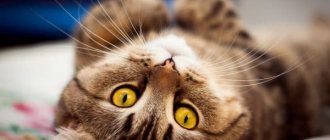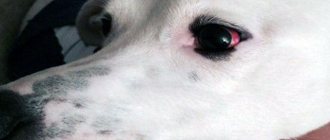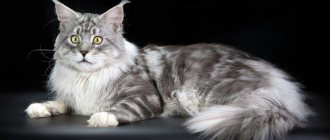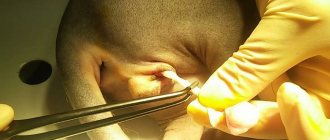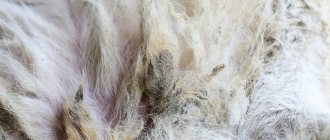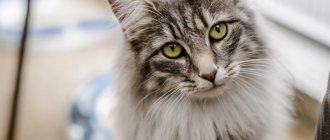Looking at how cats bask in the sun and are always looking for a place where it is warm and cozy, the question involuntarily arises - do they sweat at all? And if so, how does this happen?
In reality, as such, the function of sweating in the body of animals is not provided. Since their entire body is covered with fur, the work of the sweat glands is not as pronounced as in humans. And there are practically no glands themselves, with the exception of areas on the inner surface of the paw pads, around the nipples and anus.
In hot weather, you may notice that your cat leaves wet paw prints, but even this fact cannot be directly related to sweating. The physiologically secreted secretion is intended to mark the territory, and not to cool the body.
Where does a cat secrete sweat?
The cat's body has sweat glands, which are designed to improve heat exchange in the body of these animals. The main purpose of the sweating system is to prevent overheating. But in general, the functioning of this system in cats is far from perfect. There is practically no sweating in cats, since animals carefully monitor their condition, for example, choosing places to sleep where it is more comfortable to rest. When a cat is cold, its body is grouped, it curls up into a ball or sits with a ruff. But in the warmth, the animal’s body straightens, the cat stretches out.
Cats regulate the process of heat transfer by body position: they curl up into a ball in the cold or straighten out in the warmth.
A cat's thermometers are the nose and upper lip; these places are sensitive to even small changes in ambient temperature.
Sweat can be released through two types of glands:
- eccrine;
- Apocrine.
In humans, the main source of sweat is the eccrine glands, but in cats they are located only on the paws, more precisely, on the pads. Basically, only with their help does the cat sweat.
To see how a cat sweats, you need to look closely at the smooth floor on which the animal walks. There will be small wet marks left.
Unlike eccrine glands, apocrine glands cover the entire cat's body, but are most concentrated in four points:
- near the nipples;
- near the anus;
- on the cheeks;
- on the lips.
A cat can sweat not only from the heat, but also from strong nervous excitement. If we draw an analogy with a person, then his palms sweat at a moment of emotional stress.
How cats of different breeds sweat
The process of sweating depends not so much on the breed as on the thickness of the hair. It doesn’t matter whether the cat is long-haired or short-haired, they sweat the same, which cannot be said about their “bald” relatives - the Sphynx.
The lack of hair in sphinxes is caused by genetic features. Cats of this breed sweat all over their bodies . How strong the sweating will be depends solely on the pet: on its emotional state and health. Some representatives of the breed may sweat very little, but for others it becomes a whole problem. This cat needs to be constantly bathed or wiped with a damp cloth. And this can bring some discomfort to the owners, since the animal leaves wet brownish spots on the surfaces where it lies.
Sphynx sweat remains on the body in the form of brown spots
If the Sphynx's sweating is severe enough, then veterinarians advise having the animal diagnosed, as this may be associated with certain health problems.
Heat stroke: diagnosis and help at home
Ideally, a cat’s body temperature varies around 38-39 C. It can change throughout the day depending on the season, weather, mood and even age. When the body becomes unable to independently control the temperature, intoxication begins.
The blood thickens, which leads to a slowdown in its circulation through the vessels. As a result, accumulated toxins are not removed from the outside in a timely manner and, accordingly, there is a risk of blood clots. As a result, your cat may suffer a stroke or heart attack from the heat. To prevent this from happening, it is necessary to promptly detect the symptoms of heat stroke and prevent it in every possible way. Namely:
- Move the cat into the shade or into a closed, well-ventilated area.
- Give it cool/cold water, and if the animal dodges, force it to drink.
- Wrap with damp gauze or towel, or spray the wool with water. You can also gently apply something cool to your ears: a cloth, a household item, a food product.
- Dip the cat in cool water. A drastic method when she is already close to fainting or has a fever.
If the animal feels better after 20-30 minutes, then there is no need to take it to the veterinarian. In more severe cases, when the pulse slows down, loss of orientation in space and other uncharacteristic signs of behavior are observed, you should urgently contact a veterinary clinic.
How do cats cool down?
Due to weak sweating, cats are able to cool the body in other ways:
- Licking. In hot weather, cats actively wash and lick themselves. Body temperature decreases due to the evaporation of saliva from the surface of the fur.
- Let's drink. In the summer heat, cats can drink a lot. Water thins the blood, which helps the animal cool down and prevents health problems.
- Sleep. In hot weather, cats sleep a lot. Low mobility allows the cat's body to maintain body temperature at the same level.
- Condition of the coat. Wool plays a major role in the thermoregulation of an animal. By fluffing or smoothing the fur, a cat can cool the skin (the fur is close to the body) or conserve heat (the fur is fluffed, there is air between the hairs, which helps to retain heat inside).
- Searching for a suitable place. When the room is very hot, the animal instinctively looks for the coolest place in the house. This could be a tiled floor in the bathroom, a sink, or simply a ventilated area, that is, any surface that cannot heat up quickly.
Photo gallery: helping cats' thermoregulation mechanisms
Constant licking in hot weather helps a cat lower its body temperature.
Drinking frequently in hot weather prevents blood thickening and dehydration
When it's hot, cats look for cool places in the house.
It is worth noting that it is somewhat more difficult for kittens to carry out manipulations with self-cooling or heating. Their thermoregulation is imperfect, so they quickly freeze or overheat. Children should be closely monitored and helped to overcome discomfort. In nature, the mother cat monitors this, for example, licking them or moving them to a cool place. At home, this role falls on the owner.
Do dogs sweat?
Sweating is one way to regulate body temperature. As the liquid evaporates, the body cools. But dogs sweat a little differently than humans. Some even believe that dogs don't sweat.
There are two types of sweat glands in dogs. Apocrine glands on the skin are located throughout the body, but are not actively involved in the thermoregulation of dogs, although they protect the skin from excessive temperature increases. The purpose of apocrine glands is to secrete pheromones, due to which a characteristic odor appears, by which animals distinguish each other.
However, this smell should not be confused with the smell of a dog, which appears, as many believe, from sweat, especially in the heat. In fact, the specific smell comes from the wool, and it is caused by a lubricating secretion secreted by the glands to protect the wool.
Dogs sweat through their paw pads and interdigital membranes where the merocrine glands are located. A smaller number of these glands are located on the nose. If you observe your pet, you will notice that in hot weather it leaves wet marks on a dry surface.
What causes profuse sweating?
Excessive sweating is not typical for cats, so if this symptom appears, the owner should be wary. It can be a sign of both exposure to unfavorable factors and pathological conditions.
Diseases
When an owner notices that their pet is leaving wet marks more than usual, this may be a warning sign for them. Excessive sweating in your pet can be a symptom of various diseases. First of all, those associated with increased temperature:
- hemobartonellosis - an infectious bacterial disease that affects blood cells;
- feline AIDS, a viral disease that suppresses the immune system;
- viral leukemia - a disease associated with suppression of bone marrow functions;
- flu;
- infectious peritonitis, a fatal infection that attacks the immune system of cats;
- upper respiratory tract infections;
- panleukopenia - “distemper”, a viral disease that affects many systems of the cat’s body;
- toxoplasmosis is an infection caused by microscopic parasites.
Naturally, each of these pathologies is accompanied by a number of other symptoms. However, primary signs, which include profuse sweating, are prerequisites for urgent contact with a veterinarian.
Stress
In addition to illness, excessive sweating can cause stress. Most often, this condition is provoked by factors that irritate the nervous system, causing changes in the functioning of organs.
Stress can be short-term or it can last for a long time. Short-term stress most often passes painlessly. If an animal is stressed for a long time, then a malfunction of some system (for example, a thermoregulation system) or a disease occurs.
Causes of stress can be:
- physical damage, such as burns or injuries;
An injury to a cat is a stressful situation for it, especially if it is accompanied by long-term treatment.
- poisoning;
- hunger, vitamin deficiency;
- emotional disorders, for example, associated with moving, inattentive owner, etc.
Overheat
As the weather gets hotter, many cats may suffer from overheating. This condition may result in dysfunction of thermoregulation. A cat's body temperature can rise to 41 degrees. Signs of pathology are always clearly expressed. Prolonged overheating can be fatal. Those most susceptible to heat stroke are:
- kittens;
- pregnant cats;
- older animals.
These categories of animals are at risk because their bodies are weakened due to age or physiology. Also at risk are cats whose breed suggests a brachycephalic skull structure. In cats with a shortened muzzle, heat exchange processes are worse. This becomes a reason to pay closer attention to pets during the heat.
Cats with very long hair or thick undercoat are also at greater risk of heatstroke than others. Signs of overheating include:
- unnatural spread-eagled pose;
- breathing through the mouth with the tongue sticking out;
A cat breathing with its mouth open is a sign that the animal is overheating.
- shortness of breath;
- redness of the tongue and gums (bright red), but, on the contrary, atypical pallor is possible;
- wetness of paw pads;
- weakness and apathy;
- lack of appetite;
- severe drooling;
- vomiting with foam;
- convulsions;
- to whom (possible in severe cases).
I first observed overheating of an animal in my Thai cat. We lived in an apartment, but often went for walks together; she walked perfectly on a harness and even without it, not lagging behind me more than 4-5 steps. Not far from the house there was a forest and a meadow. And then one autumn (Indian summer) we went for a walk. The sun was shining and the weather was beautiful. About twenty minutes later, the cat began to leave the path and lie down in the thickets of grass on its side. I chalked it up to being tired; after all, we didn’t go for walks every day, and at home the animal had virtually no conditions for physical exercise. I gave her a few minutes of breathing space and then moved on. My “faithful dog” got up and followed me. And then I saw that the cat opened its mouth, stuck out its tongue and began to breathe heavily. I didn’t know how dangerous this condition was, but out of compassion for the animal, the walk ended there; the pet got home in my arms. Only later did I find out. that a cat's breathing is a sure sign of overheating, not fatigue.
Is it true that pigs don't sweat??
Pigs are warm-blooded animals, just like us humans. They need to stay cool when the temperature rises, otherwise it puts too much pressure on your body. Overheating can cause the pig's organs to shut down or cause a fatal seizure. Unlike humans, pigs cannot sweat.
When we are too hot, we release sweat through the sweat glands. The moisture that leaves then evaporates on the skin. The energy maintained by the body is released, and this process causes the blood vessels to cool. The cooling effect of moisture evaporation can cool body temperature.
There are two types of sweat glands:
- Eccrine sweat glands: These sweat glands appear throughout the human body and are the ones that allow cooling. They produce mostly water, but also contain electrolytes, including salts, which give sweat a salty taste...
- Apocrine sweat glandsHumans also have apocrine sweat glands, but they are only located in certain areas, such as the armpits. They do not emit the same substance. Instead, they secrete an oily substance that contains lipids, proteins and other substances. Although these glands can be used in sweating (sweating), this is not the case in most mammals.
Pigs do not have sweat glands, except in very limited areas. Even they don't produce moisture for cooling like we do. They have apocrine sworn glands. Apocrine sweat glands secrete a viscous secretion, which many people think gives them an unpleasant odor. The smell is actually a mixture of bacteria and these secretions. The secretions of the apocrine glands help maintain the skin in good condition. In some animals, such as dogs, it is believed to be useful for evading predators...
So pigs can't sweat. When heated, they do not release moisture to cool their internal temperature. This menas phrase sweat like a pig is completely wrong.
Tips for cat owners for hot weather
Owners need to closely monitor their cat's condition during the summer heat. You should pay attention to some recommendations that will make it easier for your cat to tolerate the heat:
- If a long-haired cat or a pet with undercoat does not tolerate heat well, they can be cut short in the summer.
- Cats need to be brushed periodically with special brushes. In addition to improving the condition of the coat, this will increase the ability to thermoregulate.
- You cannot force your cat to move actively. It is best to give the animal rest.
- Your cat should always have unlimited access to fresh drinking water.
- You cannot drive an animal from a resting place, for example, from the tiles in the bathroom. The cat instinctively lies down in the most comfortable place for itself.
The Sphynx cat requires special attention. In hot weather, such a pet can sweat profusely. It must be bathed or wiped with a damp cloth in a timely manner. Excess sweat gland secretions and blocked ducts can cause acne.
Video: how to help cats in hot weather
Prevention of blockage of the paraanal glands
To avoid problems and prevent the negative consequences of inflammatory processes, it is worth providing your pet with high-quality prevention. To do this, you need to follow these recommendations:
Walk your pet often. The less often the dog empties its intestines, the worse the secretion is removed from the glands. Walking is quite active. An insufficiently active lifestyle causes constipation in your pet and provokes inflammatory damage to the glands. Monitor your dog's diet
It is important to ensure that the stool is properly formed. This will help prevent constipation and diarrhea.
Abnormal bowel movements increase the likelihood of blockage and inflammatory damage to the paraanal glands. Excessive amounts of protein and carbohydrates in the diet often cause constipation. A dog's diet must contain a sufficient amount of fiber. It helps normalize digestive functions. Carry out hygienic procedures systematically. In this case, it is worth assessing the condition of the glands. Young animals are recommended to perform a similar check annually. For older pets this is done more often - every 6 months.
Diet
A balanced diet is a key factor in the prevention of inflammation of the paraanal glands
If your pet has a tendency to blockage of the anal glands, then it is important to ensure the normal functioning of the digestive system
If your dog eats exclusively industrial food, then you should choose from those types that are recommended for dogs with digestive problems. The serving size and number of doses are calculated by the veterinarian, taking into account the individual characteristics of the pet.
Often, the veterinarian prescribes a vitamin and mineral complex to strengthen the pet’s immunity.
Diet and an active lifestyle are the best prevention of blockage of the paraanal glands
Sonation of the paraanal glands
Pet hygiene is the responsibility of the owners. Cleaning your teeth and ears should not be difficult after some preliminary training and practice. But the issue of hygiene of the paraanal glands becomes a difficult task for some owners, and absolutely impossible for those who are particularly squeamish. If you wish, the veterinarians of the Veterinary House clinic will explain to you how to properly clean the glands in dogs, and if you do not want to perform the manipulation yourself, they will determine the interval for filling the bags and draw up the best schedule for visits to the clinic.
The anal sacs (glands) are located on the sides and slightly below the anus. These bags are gradually filled with a special secretion, with the help of which the animal marks its territory. It has an individual unpleasant odor and is a kind of personal marker of a particular individual. During each bowel movement, fecal pressure is exerted on the glands, causing fluid to be removed from the body. In other words, cleaning the glands in cats and dogs is often done independently; owners may not even know about the existence of such a problem.
When secretions accumulate inside the glands for a long time, pets begin to experience discomfort near the anus area. Following their instincts and trying to get rid of unpleasant sensations and squeeze out the liquid, dogs begin to crawl on the floor, rub against carpets or other surfaces with pile. If relief does not come, the animal begins to gnaw the area at the base of the tail, shows more and more anxiety, sometimes suddenly jumps up and tries to wriggle towards its croup, as if catching someone invisible. Feel the area under the tail using gloves for hygiene purposes. When you feel tight areas with gentle pressure, this means that the sacs are definitely full and cleaning of the anal glands in dogs should be done soon.
How to avoid blocked anal glands in a dog?
There is a list of recommendations that if you follow, you will never know that dogs are suffering from a similar illness.
- Try to arrange walks for the animal as often as possible, as this will avoid the dog having to endure waiting for the opportunity to relieve itself.
- give the animal the necessary physical activity, since a sedentary lifestyle can cause malfunctions in the dog’s body;
- pay close attention to your diet. The dog should eat a balanced and regular diet;
- During a routine veterinary examination, ask your doctor to examine your dog's anal glands, especially if you have observed any of the above symptoms.
Wool texture
In dogs, hair follicles are combined into groups (bundles) consisting of one, longest, primary (central) hair, surrounded by thinner and shorter secondary (additional) hairs (in puppies there are no secondary hairs).
The density of the coat depends on the age and breed of the dog. The softer the wool, the thicker it is. For example, in German shepherds per 1 sq. cm of skin there are 100-300 groups of follicles, and in dogs with soft hair - 400-600. The number of groups of hair follicles is determined at birth, but young puppies only have very soft-feeling downy hair. With age, the angle of inclination of the hair to the surface of the skin decreases to approximately 45° in adult dogs.
Coat color is genetically determined by the dominance of one color over another or over several other colors. This explains the range of colors and the specific variety of markings in some breeds.
Dogs have two shedding periods per year, during which the winter and summer coats change. Shedding is associated with three phases of hair follicle development. In the anagen phase, intensive hair growth occurs and the hair follicle penetrates the dermis. In most dogs, this phase lasts an average of 4 months (in the Afghan Hound it can last 18 months).
In the catagen phase, hair growth stops and the follicle regresses. During the telogen phase, the hair follicle contracts along its entire length to the point where the sebaceous gland emerges. Before hair loss, its base narrows, forming a cone shape. In place of the fallen one, new hair begins its development from the anagen phase, using the vacated channel for growth.
Hair doesn't all fall out at the same time. Shedding begins from the back of the body and gradually moves to the front. The winter coat is thicker than the summer coat and serves as good protection from the cold.
Coat replacement does not begin by chance. The signal for molting is a change in the length of daylight hours. When daylight lengthens, spring molting begins, and when it decreases, winter molting begins. Changing the external temperature does not have a decisive effect on the onset of shedding; it can only affect the thickness of the coat and the intensity of hair growth.
After molting, the coat color of dogs remains unchanged, and only in aging individuals does gray hair appear on the face
It is important to regularly monitor the cleanliness of your dog’s coat to protect it from skin diseases.
Pet treatment methods
It is important to note that you can treat your dog yourself only if it is not possible to see a doctor at the moment. To alleviate the animal's suffering, you can use rectal suppositories with ichthyol
It is also possible to use broad-spectrum antibiotic ointments, which include amoxicillin. In addition, intramuscular injections with similar antibiotics can be given. If there are regular relapses of inflammation, veterinarians recommend cleaning the glands at home or removing them altogether.
Mechanical cleaning and antibacterial treatment
Sanitation can be carried out in two ways: external and internal.
External cleaning
You can simply and painlessly clean your dog's anal glands using an ordinary napkin and Vaseline. The animal should be placed in the bathtub and its tail raised up towards its back. This position of the tail leads to relaxation of the muscles, the ducts open, which makes cleaning as comfortable as possible. Place a napkin on the sphincter area, gently press on both sides and wipe off the released secretion with the napkin. After the procedure, the anus should be lubricated with Vaseline. Then place ichthyol suppositories for three days.
When is the best time to visit a veterinary clinic?
You should go to the veterinary clinic when the situation is out of the owner’s control. After examining the animal, the specialist will carry out the necessary manipulations - cleaning and rinsing the paraanal glands and prescribe treatment.
Treatment methods
In most cases, treatment is limited to mechanical methods. Only in the most advanced cases surgical intervention is required. In general, the treatment looks like this:
- drug therapy. First of all, these are rectal anti-inflammatory suppositories, which, in addition to their antibacterial effect, have powerful regenerating properties. To reduce pain, painkillers are prescribed;
- washing. For those pets diagnosed with stage 3 or 4 of inflammation, the glands are washed to remove accumulated purulent exudate. In this case, local anesthesia is used. If an abscess is detected, the specialist will open it, remove the contents, and wash the ducts with an antiseptic. As a rule, the wound quickly regenerates if the dog is not allowed to lick the affected area. For this purpose, a special cone is prescribed, which is put on the pet’s neck;
- mechanical cleaning. This method is used when the inflammatory process is at stages 1-2. Usually there are two ways to clean the glands - external and internal. The first method involves grasping the glands from the outside and gently pressing them towards each other. The second method involves inserting a finger into the dog’s anus, with which the gland is felt. With the help of gentle massage manipulations, the contents of the organ are squeezed out. This method is usually used either by a doctor in a clinic or under the supervision of a specialist;
- surgical intervention. An operation to remove the paraanal glands—sacculectomy—is indicated in cases of frequent relapses, chronic inflammatory process, and congenital pathology. The operation is not considered complicated, since it does not affect other organs of the pet. Within a day, the dog returns to his normal lifestyle.
Sacculectomy is not a death sentence
Types of neoplasm
Seals on the skin may appear for the following reasons.
Benign tumors
They can appear on any part of the body and at any age of the animal. In the first stages they do not manifest themselves at all. Dogs begin to feel uncomfortable when the lump gets large. Bleeding may occur. They grow individually slowly. Manifest in the form of fibromas, hemangiomas, histiocytomas, histiocyosis.
Malignant tumors
Very dangerous cancer cells. They may bleed, change color, or become inflamed. They grow quickly and can move throughout the body.
Note! A dangerous sign is considered to be sudden baldness at the site of the lump at a high growth rate of the lump. The following types of cancer are distinguished:
The following types of cancer are distinguished:
- melanoma is skin cancer. Seals are found on the limbs, eyes, and mouth;
- lymphosarcoma - damage to the lymph nodes. Lumps in a joint, groin, knee or jaw;
- hemangiosarcoma - damage to skin cells;
- Mastiocytoma arises from mutated mast cells. A dog's lump appears under the skin on the withers, in the groin area, armpit area, near the ridge;
- osteogenic sarcoma - cancerous bone lesions;
- squamous cell carcinoma - affects the mouth and throat. It looks like a simple growth.
Non-tumor formations
Among non-tumor formations the following are distinguished:
- inflammation of the lymph nodes is a process in which the lymph in the neck and armpits becomes swollen. These places cause pain;
- hernia - prolapse and pinching of internal organs through openings. The lump occurs under the skin on the dog’s stomach and groin area;
- Balanoposthitis is an inflammation of the genital organs in male dogs. Accompanied by severe swelling;
- mastitis (inflammation of the mammary glands) - painful swelling of the nipples in bitches, accompanied by fever and weakness;
- post-vaccination formations. After the vaccine is administered, bumps may occur due to an allergic reaction to a component of the drug, insufficiently rapid absorption of the drug, puncture of the nerve ending, or simply due to the characteristics of this drug.
A mammary tumor is one of the serious diseases that requires urgent veterinary intervention.
Insect bites
Many dogs suffer from insect bites. In their place, redness and swelling begin to form, which itches very much. A bite can cause allergies, so you need to monitor the animal’s well-being.
Important! In case of a severe reaction, it is strongly recommended to visit a veterinarian
Hematoma
This is the accumulation of blood in soft tissues when organs are damaged. It is characterized by rupture of blood vessels and appears as a bruise. It is often localized near the ears due to blows or strong scratching. At the same time, it quickly increases in size. Severe suppuration requires surgical intervention.
Warts and papillomas
These are signs of a viral disease. They can grow either one at a time or several at once, localized next to each other. Their consistency is loose, the color can be light or dark. Papillomas develop in the oral cavity on the mucous membranes, paws, armpits, and groin area. Warts often appear on the stomach, paws, and neck.
Cyst
This is a growth filled with liquid contents. Occurs due to severe compression or blockage of the glands. It can appear in any part of the body in the upper layer of skin.
This is interesting: Animals of the Red Book of Russia
Note! The neoplasm is reddish in color, small round in shape and soft, friable consistency, usually painless
Abscess
Accumulation of pus in tissues and/or organs due to an inflammatory process. Occurs due to pathogenic bacteria in the area of open wounds. A superficial abscess forms in the subcutaneous layer, a deep one - under the mucous part and in the internal organs. It can occur on the paws, and there it grows quite quickly. The dog feels depressed, eats poorly, and has a fever. A musty odor may occur.
Pyoderma
Purulent bacterial disease. Typically found in puppies. Localized in the genital area, ears, eyes, and head. The bumps quickly spread throughout the body and fester.
Timely contact with a doctor will help your pet cope with the problem.
Important! The causes of pyoderma are associated with weak immunity
